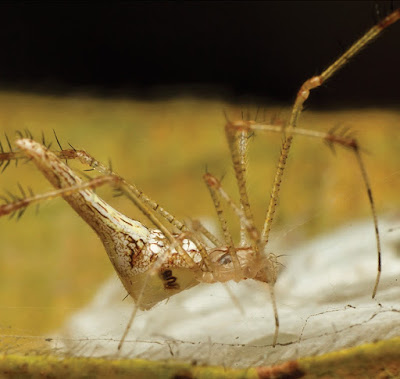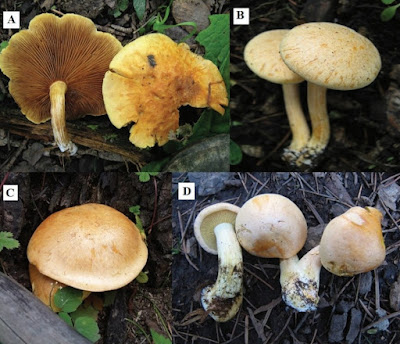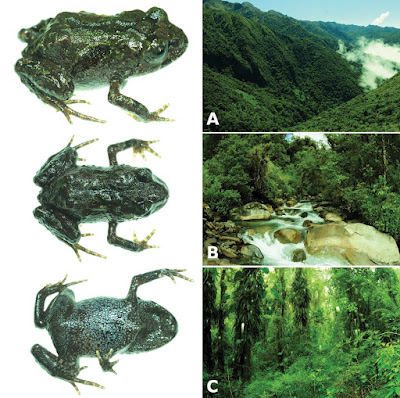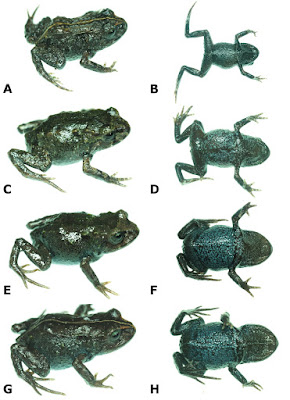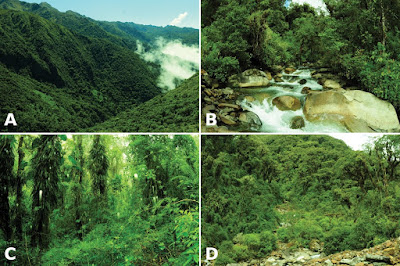[Most Recent Entries] [Calendar View]
Thursday, July 13th, 2017
| Time | Event | ||||
| 2:11a | [Arachnida • 2017] The Spiny Theridiid Genus Meotipa Simon, 1895 (Araneae, Theridiidae) in India, with Description of A Strange New Species, Meotipa sahyadri, with Translucent Abdomen and A Phylogenetic Analysis about the Genus Placement
Abstract A characteristic new species Meotipa sahyadri n. sp. with tall and white translucent abdomen in females is described in detail based on morphology of both sexes, based on specimens collected from the Western Ghats of Maharashtra, Gujarat and Goa. The new species has epigynal projection which is known only in Meotipa picturata Simon, 1895, but differs in shape (trifid vs. quadrangular respectively). Males have longest straight embolus exceeding conductor length. Observations of its natural history are provided. Meotipa picturata is newly recorded from Goa, which extends its north-westward distribution from the previously known records from ‘Kodei Kanal’, India (type locality), Ratchasima Province, Thailand and East Kalimantan, Indonesia. A new combination Meotipa andamanensis (Tikader, 1977) n. comb. (=Argyrodes andamanensis) is proposed based on the comparison of description and illustrations provided in the original paper to that of the characters of the type species M. picturata. 242 morphological characters studied in the previous literature and one additional character ‘epigynal projection’ were scored for Meotipa sahyadri n. sp. and Meotipa picturata. These species were obtained monophyletic, placed within Theridiinae as sister to Chrysso cf. nigriceps using parsimony analysis and Bayesian inference. Keywords: Araneae, Taxonomy, Comb-footed Spiders, Morphology, Phylogeny, Asian Tropics, Western Ghats Siddharth Kulkarni, Atul Vartak, Vishwas Deshpande and Dheeraj Halali. 2017. The Spiny Theridiid Genus Meotipa Simon, 1895 in India, with Description of A Strange New Species with Translucent Abdomen and A Phylogenetic Analysis about the Genus Placement (Araneae, Theridiidae). Zootaxa. 4291(3); 504–520. DOI: 10.11646/zootaxa.4291.3.4 | ||||
| 8:30a | [Fungi • 2017] Gymnopilus penetrans and G. swaticus sp. nov. (Agaricomycota: Hymenogastraceae); A New Record and A New Species from northwest Pakistan
Abstract Two Gymnopilus species are described and illustrated from northern parts of Khyber Pakhtunkhwa province, Pakistan. Gymnopilus swaticus is described as new to science based on morphological characters and data from nITS and nLSU. Gymnopilus penetrans is a new record for Pakistani mycobiota. Keywords: agaricoid fungi, DNA sequences, molecular phylogeny, Swat district, taxonomy, Fungi
Gymnopilus swaticus J. Khan, Sher & Khalid sp. nov. Diagnosis:— growth on Piceae smithiana, fruiting body 40‒70 mm across, pileus velutinous to slightly tomentose, subdistant to close and sinuate to emarginate lamellae, ellipsoid to amygdaliform basidiospores measuring 8.6–10.0 × 4.5–5.6 µm. Type:—PAKISTAN. Khyber Pakhtunkhwa province, Swat district, Gabin Jabba valley Lalkoo, in decomposing cavities of Picea smithiana, 2483 m a.s.l., 31 August 2015, Junaid Khan GJ-1518 (Holotype SWAT000133!). Etymology:—the specific epithet “swaticus” refers to the district of collection, Swat. Habitat:— in small scattered groups, in decomposing cavities of standing trees of Picea smithiana. Junaid Khan, Munazza Kiran, Sana Jabeen, Hassan Sher and Abdul Nasir Khalid. 2017. Gymnopilus penetrans and G. swaticus sp. nov. (Agaricomycota: Hymenogastraceae); A New Record and A New Species from northwest Pakistan. Phytotaxa. 312(1); 60–70. DOI: 10.11646/phytotaxa.312.1.4 | ||||
| 4:20p | [Herpetology • 2017] Bryophryne phuyuhampatu • A New Species of Cusco Andes Frog (Anura, Craugastoridae) from the Cloud Forest of the eastern Slopes of the Peruvian Andes
Abstract A new species of Bryophryne from the humid montane forest of the Department of Cusco, Peru, is described. Specimens were collected at 2795–2850 m a.s.l. in the Área de Conservación Privada Ukumari Llaqta, Quispillomayo valley, in the province of Paucartambo. The new species is readily distinguished from all other species of Bryophryne by having green coloration on dorsum, and blue flecks on flanks and ventral parts. Specimens are characterized by lacking a distinct tympanic annulus, tympanic membrane, and dentigerous processes of vomers, and by having dorsal skin shagreen, discontinuous dorsolateral folds, skin tuberculate on flanks, skin areolate on ventral surfaces of the body, and fingers and toes without lateral fringes or webbing. The new species has a snout–vent length of 14.2–16.9 mm in three males and 22.2–22.6 mm in two females, and is smaller than all other congeneric species except for B. abramalagae. Generic allocation is supported by low genetic distances of the 16S mitochondrial gene and morphological similarity with other species of Bryophryne, and geographic distribution. Bryophryne phuyuhampatu sp. n. is only known from the type locality, a cloud forest along the Quispillomayo River in the upper Nusiniscato watershed. Keywords: leaf litter amphibian, montane forest, Paucartambo, taxonomy Diagnosis: A new species of Bryophryne characterized by: (1) skin on dorsum shagreen; skin on venter areolate, discoidal fold absent, thoracic fold present; dorsolateral folds irregular and discontinuous; (2) tympanic membrane and tympanic annulus absent; (3) snout rounded in dorsal view and in profile; (4) upper eyelid with two small tubercles, narrower than IOD; cranial crests absent; (5) dentigerous process of vomers absent; (6) vocal sac and slits absent; nuptial pads absent; (7) Finger I much shorter than Finger II; tips of digits slightly pointed; (8) fingers lacking lateral fringes; (9) outer edge of forearm bearing small tubercles; (10) heel bearing minute tubercles; inner tarsal fold absent; outer edge of tarsus bearing small tubercles; (11) inner metatarsal tubercle prominent, ovoid, of similar relief and slightly larger than ovoid, outer metatarsal tubercle; supernumerary plantar tubercles indistinct; (12) toes lacking lateral fringes; webbing absent; toes III and V about equal in length; tips of digits slightly pointed; (13) in life, dorsum tan to green and brown with dark brown markings, greenish blue on lower flanks; some specimens with a yellow middorsal line extending from tip of snout to cloaca and to the posterior surface of thighs; interorbital bar present; chest, belly and ventral parts of forearms and legs dark brown with grayish blue flecks; throat brown with flecks turning from gray-blue to copper near tip of mouth; palmar and plantar surfaces brown with lighter fingers and toes; (14) SVL 14.2–16.9 in males (n = 3), 22.2–22.6 in females (n = 2). Etymology: The specific name phuyuhampatu is a combination of Quechua words used in apposition meaning “toad” (“hampa'tu”) that lives in the “fog” (“phuyu”). Distribution, natural history, and threats: Bryophryne phuyuhampatu was discovered during a rapid amphibian survey in the upper Quispillomayo Valley (Fig. 5A) from 22 to 31 May 2016. The Quispillomayo torrent (Fig. 5B) is a tributary of the Nusiniscato River, which reaches the Araza River downstream of Quincemil, in the upper Madre de Dios drainage. During the inventory high-Andean grasslands (puna; 3350–4515 m a.s.l.), a forest patch of tasta (Escallonia myrtillioides), kishuar (Buddleja incana) and qeñua (Polylepis incana) at 4280 m a.s.l., montane scrub, disturbed areas and other transitional formations along the treeline around 3350 m a.s.l., and the montane cloud forest from 2780–3350 m a.s.l. were sampled. Frogs were searched for under rocks, logs, mosses, and in the leaf litter and the understory in the montane forest. All but one specimens of B. phuyuhampatu were found under mosses in the cloud forest around 2850 m a.s.l. (Fig. 5C). Male MUBI 14655 was found ~250 m from this site, under rocks and mosses under the riparian vegetation at the confluence of a small stream at 2795 m a.s.l. Two sympatric frogs, Gastrotheca cf. excubitor and Psychrophrynella chirihampatu, were found under rocks in disturbed habitats (i.e., along streams, landslides) but not in the cloud forest. Two additional amphibian species, Bryophryne sp. and B. cf. zonalis, were found along with G. cf. excubitor in the grasslands from 3100–3650 m a.s.l. Alessandro Catenazzi, Alex Ttito, M. Isabel Diaz and Alexander Shepack. 2017. Bryophryne phuyuhampatu sp. n., A New Species of Cusco Andes Frog from the Cloud Forest of the eastern Slopes of the Peruvian Andes (Amphibia, Anura, Craugastoridae). ZooKeys. 685; 65-81. DOI: 10.3897/zookeys.685.12152 Resumen: Se describe una nueva especie de Bryophryne de los bosques nublados del Departamento de Cusco en Perú. Los especímenes fueron colectados a una elevación de 2795–2850 m en el Área de Conservación Privada Ukumari Llaqta, valle del río Quispillomayo, provincia de Paucartambo. La nueva especie se diferencia fácilmente de todas las demás especies de Bryophryne por tener coloración verde en la espalda y manchitas azuladas en los flancos y las superficies ventrales. Los especímenes se caracterizan por carecer de procesos vomerianos y de anillo y membrana timpánicos, y por poseer piel dorsal finamente granulada, pliegues dorsolaterales discontinuos, piel en los flancos verrugosa, y cubierta de verrugas en areola en las partes ventrales, y por carecer de membrana basal y quillas laterales en los dedos. La nueva especie tiene una longitud hocico–cloaca (LHC) de 14.2–16.9 mm en tres machos y de 22.2–22.6 mm en dos hembras, siendo menor que todas las demás especies de Bryophryne excepto por B. abramalagae. Distancias genéticas bajas para el gen mitocondrial 16S, similitud morfológica con otras especies de Bryophryne y distribución geográfica indican que la nueva especie forma parte del género Bryophryne. Bryophryne phuyuhampatu sp. n. se conoce únicamente de su localidad tipo, un bosque nublado en el valle del torrente Quispillomayo, en la parte alta de la cuenca del río Nusiniscato. Palabras clave: anfibio de hojarasca, Paucartambo, bosque nublado, taxonomía |
| << Previous Day |
2017/07/13 [Calendar] |
Next Day >> |
